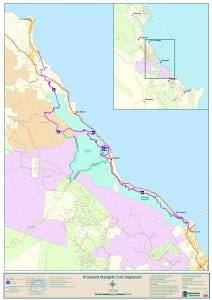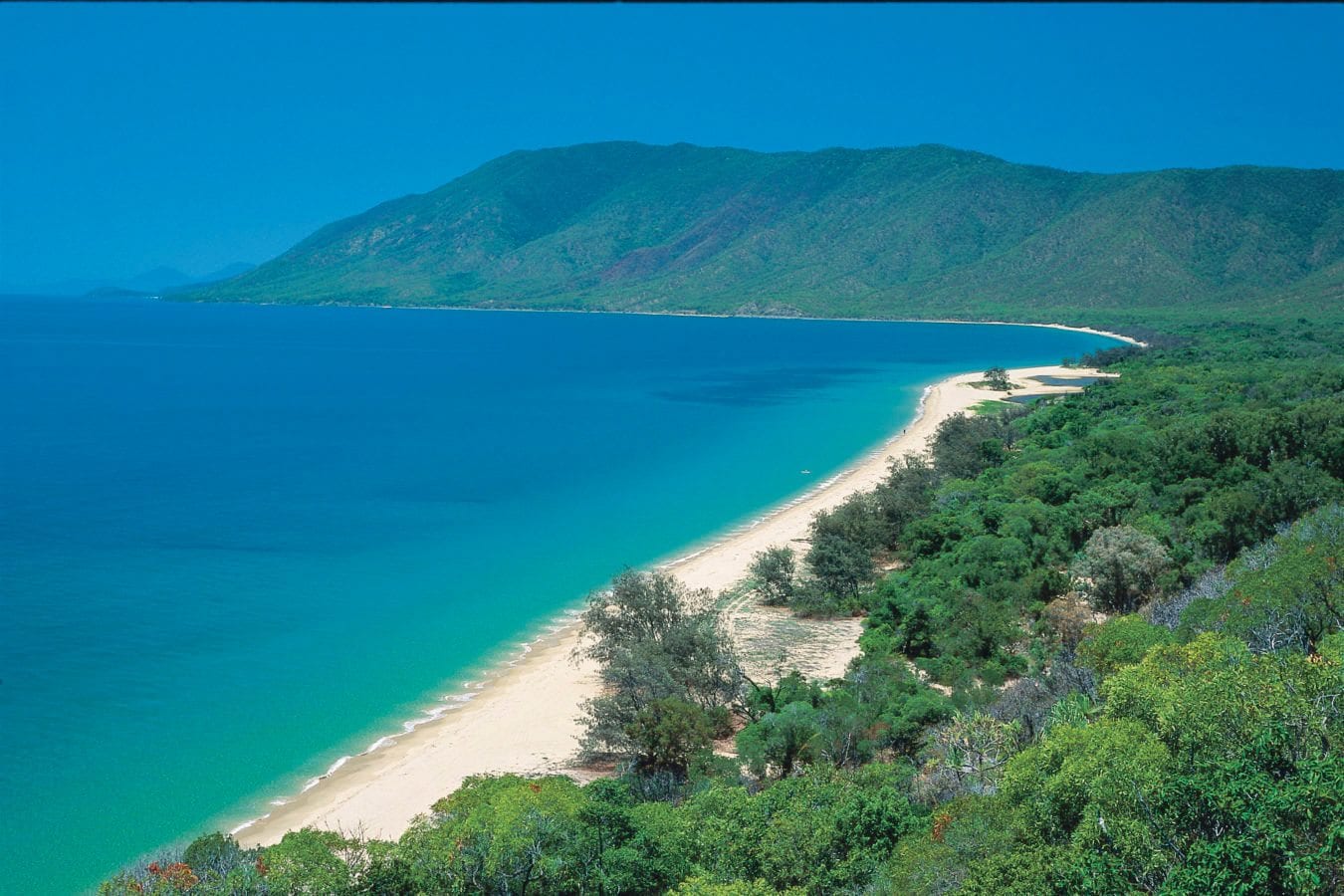
The Wangetti Trail Proposal plans to introduce mountain biking and private accommodation (new activities/impacts) into Macalister Range National Park, Mowbray National Park, Kuranda National Park and the Wet Tropics World Heritage area.
NPAQ is strongly supportive of a walking track only version of the Wangetti Trail.
View map of proposal here, noting that this map is conceptual only and subject to approvals.
NPAQ supports and actively promotes access to national parks and World Heritage areas that enable visitors to enjoy and appreciate the scenic, cultural and conservation values of these protected areas. NPAQ does not support access for activities that are incompatible with the purpose of national parks, the conservation of nature as enshrined in the Nature Conservation Act 1999 (Qld).
NPAQ concerns:
- Assessment of impacts should be complete to consider all cumulative impacts appropriately. A piecemeal approach to impact assessment (and consultation) has been undertaken by the Proponent.
- The Wangetti Trail Proposal should be assessed under the EPBC Act as one complete “controlled action” (including alternatives to the proposal). The Proponent is seeking approval for “not a controlled action” and split the proposal into two sections. The proposition that numerous identified impacts, along with the introduction of mountain biking into three national parks and the Wet Tropics World Heritage Area, is not significant enough to trigger a controlled action is questionable. Also, details of private commercial accommodation such as vehicle movements and other services are required to properly assess cumulative impact.
- The public should have a say on the details and impacts associated with development in national parks. There has been no public consultation, to date, on the impacts on Matters of State Environmental Significance. (Note: Council development approvals that may occur in the future are not expected to address issues on national park land.)
- Mountain biking should be removed from the proposal as it is contrary to the purpose of national parks and will have negative impacts on intrinsic World Heritage values and would undermine the experience of walkers and other low impact users. There are many other mountain biking opportunities in the region.
- Impacts on the national park and World Heritage area have been underestimated. Mitigation is rarely implemented fully and consistently over the long term. The full explicit support of the land manager (QPWS) has not been documented. The proposed Queensland Parks and Wildlife Service maintenance schedule can only be considered aspirational given the known underfunding of the Service.
Have your say!
Federal issues:
http://epbcnotices.environment.gov.au/publicnoticesreferrals/ and search for Referral Numbers 2020/8722 and 2020/8723. Send submissions to epbc.referrals@environment.gov.au
State issues:
https://ditid.mysocialpinpoint.com.au/wangetti-trail-community-consultation#/
Submissions are due Friday 11 September to QldEcotourismTrails@ditid.qld.gov.au
Want to know more? …
Cumulative impacts
Cumulative impacts should be assessed in their entirety; phased assessments are insufficient. The scale, type and servicing of ecotourism accommodation has not been fully detailed in consultation:
- Federal issues – Environment Protection and Biodiversity Conservation Act 1999 (Cth) EPBC referral see EPBC Referral Portal and search for Referral Numbers 2020/8722 and 2020/8723). The proposal including the north and south parts as well as the details of any eco-accommodation (e.g. including impacts of all associated services – vehicle movements, fire management), should be assessed as a whole. This issue has been identified as a failing of the implementation of the Environment Protection and Biodiversity Conservation Act 1999 (Cth) in the Independent Review of the EPBC Act: Interim Report, (Samuel, June 2020). COVID-19 is an unacceptable reason to allow piecemeal assessment as biodiversity and threatened species habitat continue to decline in Queensland and Australia.
- General/state issues – Mysocialpinpoint. No assessment of impacts on State Significant Values has been provided (note – future Council Development Assessments will not address impacts on National Park Land).
Intact nature/integrity of the World Heritage area
The proposal intersects with the Wet Tropics World Heritage area (WTWH area) and the Macalister Range National Park, Kuranda National Park and Mowbray National Park. The WTWH area meets the criteria for outstanding universal values of natural beauty, endemic biodiversity, ecological processes and cultural values criteria. This area is largely intact and is enjoyed by a wide range of low impact recreational users such as walkers, bird watchers and photographers. Mountain biking is incompatible with the purpose of a national park and World Heritage area and will undermine the natural experience of these users.
The proposed development would bisect areas of “high degree of ecological sensitivity” and introduce new, higher impact activities. The impacts of both legal and illegal mountain biking are well documented including loss of vegetation, erosion, species behaviour/reproductive success, and sedimentation. Construction and operation of the proposal would open up a wide area of World Heritage area to mountain biking, which is otherwise hard to access. Impacts would be exacerbated by extreme weather events associated with the wet tropics.
The proposed development would also introduce additional management requirements to the already undersized, underfunded and under stress Queensland National Park Estate (only 5.2% of Queensland – the lowest percentage in Australia). The additional compliance, monitoring and maintenance work associated with such a mountain biking proposal would detract from the under resourced Queensland Parks and Wildlife Service as outlined in the Queensland protected areas financial sustainability strategy (Queensland Treasury Corporation, September, 2018).
Alternatives to the proposal
The referral indicates there are no alternatives to the proposal. NPAQ disputes this. The region is already well represented by mountain biking tracks, which the Outdoor Queensland (formerly QORF) has stated is in need of maintenance funding. One alternative to be considered is restricting the proposal to a lower costing and impact walking track only and investing funds into the maintenance of existing off-park mountain biking tracks. This would then truly be a “great coastal walk”.
Wet Tropics Management Permit
According to the Wet Tropics World Heritage Protection and Management Act 1993 (cth), the “Authority must consult with the community, both through its committees and directly and extensively on matters with significant community impact”. NPAQ is concerned the Wet Tropics Management Authority Permit to construct the Wangetti Trail Proposal (WTMA20001 dated 17 June) was issued prior to any public consultation on the details of the design and associated environmental impacts. (The public consultation conducted through the Tourism Department’s My Social Pinpoint interactive tool https://ditid.mysocialpinpoint.com.au/wangetti-trail-community-consultation#/ provides no information on the environmental values of the land or the impacts of the proposal). Further, the Permit has limited content on operational mitigation (e.g. information/warning signs which are often ineffective).
Consultation/bypass
The Proponent’s Consultation Report suggests engagement with NPAQ was substantive (e.g. “regular informal discussions”); however, information provided by the Proponent was typically limited to high level generalities and an alignment, and included no detail on the design or assessment of impacts (prior to the EPBC referral). Also, the Proponent’s recent addition of a Mountain Biking Bypass in response to NPAQ concerns with mountain biking involves use of an illegal road (Quaid Road), which, under the Wet Tropics World Heritage Area Management Plan is closed to public access. Use of the bypass would open up access to this part of the WH area and facilitate wider access by mountain bikes, and potentially trail bikes, introducing new risks of collision with wildlife and spread of weeds and pathogens (not properly addressed in the assessment).
Mountain biking
Overall, mountain biking is incompatible with the purpose of national park and World Heritage areas. Mountain biking and walkers are generally incompatible. If any cycling is considered further, it should be limited to leisure cycling and explicitly exclude mountain biking.
Gradients of above 6+% are likely to result in increased speed of cyclists. Gradients of up to 15% (although short), combined with a 1.5m wide trail, will likely encourage thrill-seeking speed and therefore negative interactions with both walkers and wildlife.
Impact assessment versus practice
The ecological assessment recommends numerous mitigation measures; however, in practice, these are rarely implemented fully or maintained in the long run (e.g. signage has limited efficacy and rangers resources across the Queensland National Park Estate are known to be deficient). In addition, NPAQ is concerned that introducing 11,000 visitors a year and 70+ watercourse crossings (that are likely to require “replacement every 10-20 years“ following “extreme weather events”), will potentially create significant impacts on Matters of National and State Environmental Significance.
Threatened Species
The Critically Endangered Opal cling goby is known to inhabit Turtle Creek, Spring Creek and Hartley’s Creek as identified in the Conservation planning for cling gobies and short-steep-coastal-stream in the Australian Wet Tropics (Ebner, May 2016). The proposed development will cross (be upstream of) known habitat. It is unclear how an assessment of “not significant” as suggested by the Proponent’s consultant is justifiable (e.g. extreme weather will affect crossings every “10-20 years requiring replacement”).
The 17 km section of dedicated mountain bike trail will introduce speed orientated mountain biking into two national parks the World Heritage area including in known territory of the Endangered southern cassowary.
Impact assessment versus practice
The ecological assessment recommends numerous mitigation measures; however, in practice, these are rarely implemented fully or maintained in the long run (e.g. signage has limited efficacy and rangers resources across the Queensland National Park Estate are known to be deficient). In addition, NPAQ is concerned that introducing 11,000 visitors a year and 70+ watercourse crossings (that are likely to require “replacement every 10-20 years“ following “extreme weather events”), will potentially create significant impacts on Matters of National and State Environmental Significance.
Can you help?
NPAQ has not reviewed the impact assessment of all threatened species yet. Have time and expertise? Email conservation@npaq.org.au
And/or send your concerns to epbc.referrals@environment.gov.au and QldEcotourismTrails@ditid.qld.gov.au.


